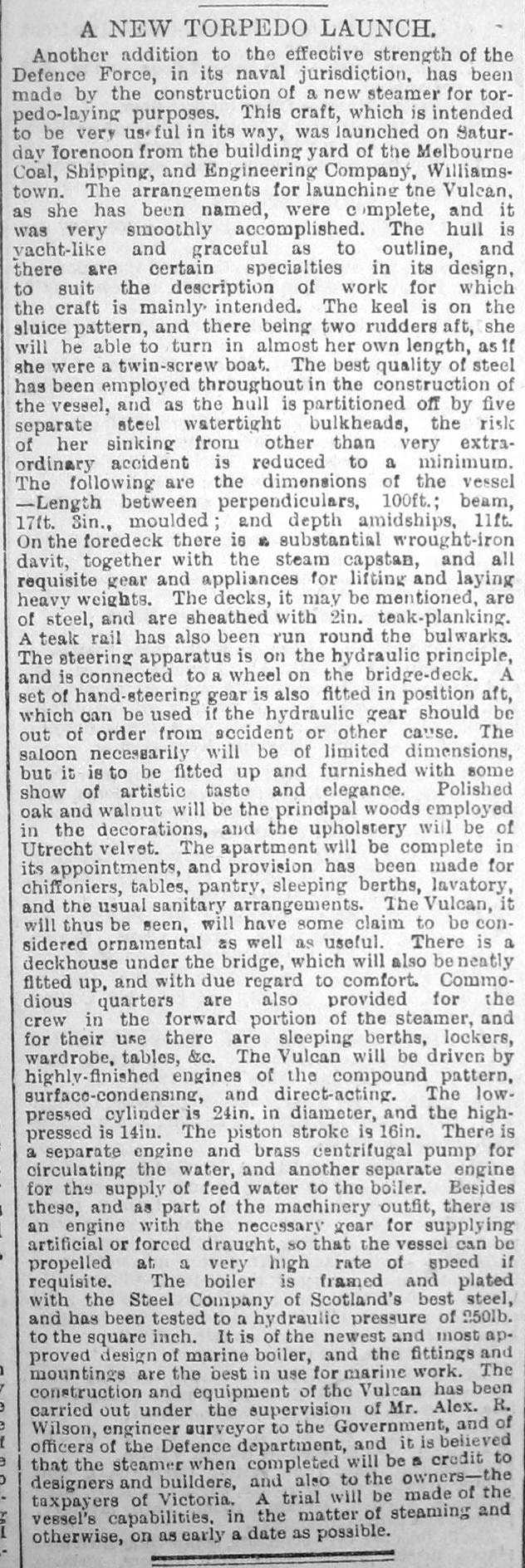Ship Index
| ||||||||||||||||||||||||||||||||||||||||||||||||||||||||
THE supplement presented this month of "Our Navy" gives a representation of four vessels, the Cerberus, the Nelson, the Victoria, and the Pharos, which at present constitute our war fleet, so to speak. That this colony should aspire to possess such an institution may be deemed Quixotic by some, and ridiculous by others; but as there is no attempt at aping the armaments or the great naval powers, and as the vessels comprising our fleet are engaged at present in quite other than destructive purposes, we do not altogether coincide with this opinion. Just as we have a volunteer force as be commencement of our army of the future (should that unfortunately ever be required), and as the military training received by the members fits them for campaigning, should the necessity arise, so we have, on the other band, the germ of a naval force in the vessels forming the subject of our engraving, and in the men who are being trained on board in marine artillery practice and naval tactics generally. In these present "piping times of peace," when "grim visaged war has smoothed his wrinkled front," and the lion and the bear, at least, are lying down together, it may be considered superfluous and uneconomic to maintain either military or naval force in such a sparse community as ours. The millennium, if imminent, has not, however, yet arrived, and so long as " wars and rumours of wars "are liable to crop up, it is well, even in a small way, to be prepared for any emergency that may arise.
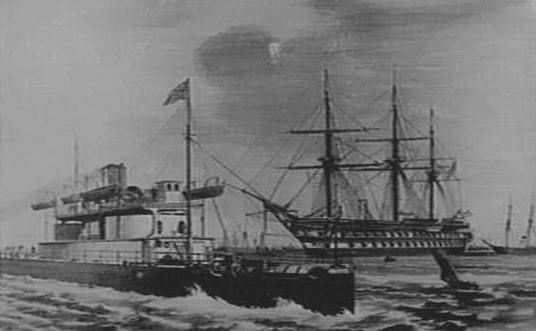
Although the vessels of "our navy" are few in number, they are singularly diverse in appearance, and in the Nelson and the Cerberus we have the extremes of a century in the agencies employed in naval warfare. Two vessels more unlike each other, and yet constructed for almost the same purpose, can scarcely be imagined-the one the very ideal of the line-of-battle ship of naval romance, bristling with cannon and towering on the waves like a "castle of the deep;" and the other low, uncouth, and grim, and looking like a half-tide rock in the water, or, as has been irreverently expressed, like n floating gaswork, the two turrets being the gasometers. The duties performed by the vessels of "our navy" are no less varied than the appearance each presents; for while the Cerberus is retained exclusively for defence of the port, the Nelson is utilised as a training ship for boys who are indebted for their bringing up to state parentage, and in the reclaiming of street Arabs and the youthful Bedouins of our social community the old ship has performed, and still continues to perform, a most important part. The Victoria-the first vessel having pretension to naval status which the colony acquired, was for some time a show ship, or nearly so, until occasions arose when signal service was rendered by her, and both in these colonies and in New Zealand her presence was found eminently useful. Of late years she has been chiefly engaged in marine survey work along the coast, The Pharos is used chiefly for harbour work, for which purpose she was built. Her duties consist principally in taking up and replacing buoys and beacons, and in conveying stores, materials, etc., to the various lighthouses and coast telegraph stations of the colony. Like the Victoria, she has also been engaged in the cause of humanity, and on more than one occasion she has been sent to scenes of shipwreck to render succour and assistance. Some details concerning the vessels of "our navy" are appended, and as first in importance, although not largest in size, we give
For the purposes of harbour defence against an attacking force the Cerberus is admirably adapted, and in this consists her chief value. She is an armour-plated vessel, or what is technically known as a "turret ship," and is constructed on the same principle as the Magdala and Abyssinia, and other vessels of a cognate character in the British navy. In order to afford adequate protection to the shipping and port of Melbourne, it was agreed to make application to the Home Government for such a vessel as the Cerberus, and the request was readily granted, the colony paying a portion of the cost of her constriction and equipment, and the British Government the remainder. She was begun in October, 1867, and was draughted by Mr. E. J. Reed, chief constructor for the navy. The order for her construction was given to Messrs. Palmer, of the Jarrow Iron Works, Newcastle-on-Tyne, at whose establishment the iron-clad frigate Defence was built for the Royal Navy. In length she measures between perpendiculars 225 feet, her beam being 45 feet, and depth 16 feet 6 inches, and her burthen is 2,107 tons. Her design, like the other floating fortresses already mentioned, is on what is known as the breastwork principle, which is to protect the ship all round to a height of about 12 feet above the line of flotation. The breastwork is of immense strength, and for about three feet and a half above the water line it is plated with armour eight inches in thickness, and for a like distance below the water it is plated with iron six inches thick, tapering to five inches and. four inches fore and aft. These iron plates are backed with teak planking 11 inches and. nine inches thick, according to the thickness of the plating, and inside of this again are two skins of iron plate, so that the vessel is rendered well-nigh invulnerable. The breastwork includes the main fighting portion of the vessel, and at one end of it are the turrets, while inside of it are two engines for working them. The turrets are constructed to carry each two 18-ton guns, and these are of the newest and most effective description. The turrets, which can be worked by manual or steam power, revolve once in one minute, and the weight of each, guns included, is something like 200 tons. The guns are 10-inch bore, muzzle loading, and made to carry 400lb. shot or shell. They will send shot a distance of four miles, and every precaution is made for recoil. When engaged in action the ship can be covered, and the whole of the crew on board can be directed without a man being exposed to the enemy, and if she were to be boarded by a hundred or more men they would be unable to injure her, or prevent her blazing away with her guns. The ship has also a double bottom, so constructed that it can be filled with water, and the vessel sunk to within two feet of her water-line. This space is dividcd into two compartments, and is an element of safety, her lower deck is partitioned off into eight watertight compartments. There is ample ventilation secured throughout by strong currents of air driven by steam fans, and means are taken for the escape of foul air. The Cerberus is propelled by twin screws, so that she can turn on her own length, and the screws are fitted with Maudslay's Shifting blades. Her engines were made at Maudslay and. Field's works, London. They are very effective, and drive her at a speed of 9 ½ knots. Her interior is literally crammcd with machinery, and there are on board engines for working the turrets and the capstan, pumping water into the ship and out of it; for hoisting and fanning. and a variety of other purposes. This machinery was supplied by Messrs. Palmer, the builders of the vessel. The Cerberus was brought out here by Captain W. H. Panter, formerly of the Royal Navy, but who now commands the Victorian navy. Captain W. H. Norman, of the Victoria, had gone home for her, but he died before the Cerberus was ready for sea. A start was made on November 7, 1870, and after coming through the Suez Canal, and calling at various points afterwards, she reached Hobson's Bay on April 9, 1871. The Cerberus was taken into the Alfred Graving Dock recently, and not before time, for the growth of marine crustacean and parasites under her water-line was something extraordinary. The Cerberus, at stated times, goes down the bay for shot and. shell practice, and on such occasions she is manned, in addition to her own crew, by members of the Naval Reserve Force. This force, it may here be mentioned, numbers over 200 men, commanded by Captain R. Fullarton and Lieutenant Elder, and Sub. lieutenants Bland and Dennis. The Cerberus is commanded by Captain W. H. Panter, Mr. Leslie, R.N, is chief engineer, and the guns and all thereunto pertaining are in charge of Mr. Pounds, formerly gunner of the Nelson. Leaving the Cerberus, we come next to
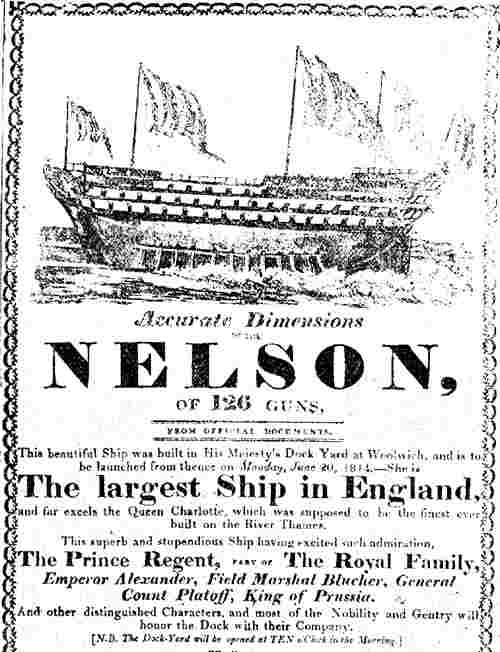
one of the finest specimens extant of the "wooden walls of Old England," and between which and the Cerberus there is very little affinity. The Nelson was sent out here by the Admiralty to form a portion of our port defences, and to be used as a blockship, and also as a training school for boys of our colonial navy. The Nelson was launched in 1814 as a line-of-battleship, and was pierced for 120 guns. She lay for years, however, without being fitted out or equipped, but In 1860 she emerged from her obscurity, and was lengthened and. converted into a screw steamer. She had originally five decks, but the upper deck was razeed, or cut down, and a spacious poop deck left. She has now an upper deck, main deck, lower deck, and orlop deck. On the lower deck she carries 20 rifled guns (68-pounders), and on the main deck a similar number of 32-pounders. She has also two formidable pieces of ordnance, on pivot slides, in the forecastle. These latter are seven-and-a-half ton guns, and carry 150lb. shot. On the upper deck there are also six small brass 12-pounders for boat-work or field-work. The boys are exercised at the light 32-pounders, which are found useful for such purpose; and the men of the Naval Reserve force train with the guns of larger calibre on the lower deck.
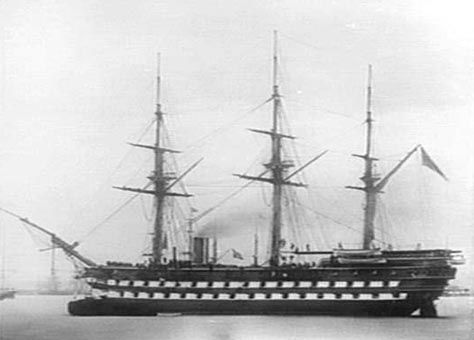
The Nelson is well furnished with all the munitions of war, and she has on board guns the shot from which would penetrate the plating of ironclad like the Warrior or Gloire. When she left England for the colonies she was the only line-of-battle ship in the navy which possessed such an armament. It is in the cause of peace, however, that the Nelson at present does duty. Soon after her arrival here she was got ready for the reception of boys who had become a burden on the state, either through the death of their parents or desertion by them; and of these waifs and strays no fewer than 1,200 have been received on board up to the present time. The average annual number on the list is about 350, and for the control of these, and for the performance of other duties on board, there is a staff of 36 officers and men. The boys receive a first-class education from competent teachers, and, as a rule, prove apt scholars. They are also trained to habits of strict discipline, and all over the ship there are evidences of order and scrupulous cleanliness. In addition to instruction in nautical matters, many of the boys are taught a trade, and sailmaking, and carpentering, as well as tailoring and shoemaking, are, or were, carried on to a considerable extent. As the lads grow up, some are transferred to the Cerberus or Victoria, others enter the merchant service, and not a few are taken into service by respectable tradesmen, farmers, and others, and, as a rule, the lads turn out well, and give great satisfaction. The Nelson was brought out here In February, 1860 (sic), by Captain C. B. Payne, the present chief harbour-master, and she made the voyage successfully via the Cape of Good Hope. The ship at present is in charge of Lieutenant F. Turner, who has under him Sub-lieutenant Heathcote and other officers. The men of the Naval Reserve force are also exercised at the guns on board the Nelson. From the Nelson we come to
Cutting Down HMVS Nelson in 1878This vessel has not the strength of the Cerberus, nor yet the dimensions of the Nelson, and at all points differs widely from either. What she lacks in bulk, however, she possesses in beauty, and a finer model of a vessel of her class has never been seen in these waters, her lines being the perfection of symmetry. The Victoria was built and equipped as a sloop of war, and was launched in 1855 from the yard of Messrs. Young, Son, and Macnay, on the Thames. She was draughted by Oliver Lang, of the Naval Dockyard. and was built for the Victorian Government, under the superintendence of Captain W. H. Norman, who held command of her until his death In 1867. The Victoria has an armament of seven guns, six broadside, and one long 32-pounder forward. This latter was exchanged for an Armstrong gun of larger calibre during the last Maori war.
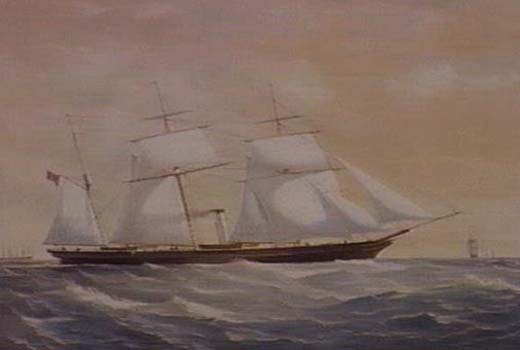
She is 176ft, in length, and is propelled by a screw driven by horizontal trunk engines of 120-horse power. The engines were made by Rennie, of London, but during the years she has been here they have undergone considerable repair, and in some portions renewal. The Victoria, during the first year or two of her career here, was employed in the Water Police department. One of her earliest cruises was to Port Curtis, to bring back repentant diggers from that overdone and disastrous rush. In 1860 she did good service by taking over troops and stores from Hobart Town to New Zealand, where she remained for some time, and was most useful as a despatch boat, and also in conveying men and military stores to the various ports. After playing her part in New Zealand, she was despatched in 1861 to the Gulf of Carpentaria, with instructions to meet, the Burke and Wills exploration party, and a few years afterwards she was engaged in the cause of acclimatisation, having been selected to convey salmon ova over to Hobart Town. No small portion of her time has also been spent in looking after wrecked vessels, and. in 1859 she brought on the passengers and crew of the steamer Thistle, which was lost off Port Albert. She was also at the wreck of the Netherby at King's Island, and. in 1865 she made a trip to Auckland Island, where the Invercauld and the General Grant were lost. Before leaving the island she left stores and live stock for the use of any shipwrecked people who might land there. Of late years she has been engaged exclusively in marine survey work, under Captain H. J. Stanley, R.N., and recently she made a trip to Sydney to bring His Excellency Sir George F. Bowen here. The Victoria was an idea of Sir Charles Hotham's, but he died before she came out here. The officer at present in charge of the Victoria is Lieutenant G. P. Tandy. After the Victoria comes
which differs from the others in that she has not yet been equipped as a war vessel, and that she is entirely a colonial production. The Pharos is a composite-built vessel, and was modelled by Mr. Douglas Elder, of the Government Marine Yard. She was launched in 1865, and was built specially for harbour work-taking up and replacing buoys. and transporting stores to the lighthouses. She is a compact little craft, of about 120ft. in length, and 20ft. beam; and should the occasion arise she could easily be converted into a gunboat. Her engines were made by Fulton, of Melbourne, from designs furnished by Mr. J. Wilson, Government Marine Engineer. They work well, and drive her along at a speed of about eight or nine knots. The Pharos has also been engaged in coast survey, and, like the Victoria, has frequently been turned to good account in looking after wrecks, her latest cruise in this respect being to King's Island, to the spot where the large iron clipper ship British Admiral was recently lost. She is kept in first-rate order, and although she has been some eight or nine years afloat, she has still the original metal on with which she was sheathed.
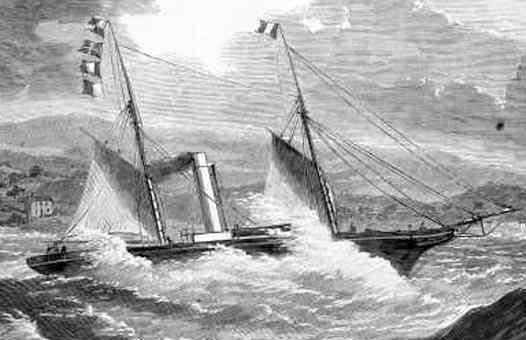
In addition to the foregoing the Victorian Government have also two small paddle steamers-the George Rennie and Bendigo -both of which are employed in the dredging department. All fly the Victorian flag, which is the ordinary blue ensign of the Royal Navy with the constellation of the Southern Cross in white stars on the fly.
Ships Index
